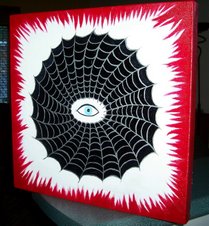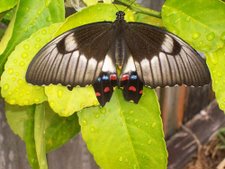
This is a picture of my small collection of Gallipoli pieces. The story behind them may be of interest. In October, 1988 I took a small group of College students on a visit to Gallipoli in Turkey. At Canakkale I went to the Troy Anzac Travel Agency to obtain advice and a guide for our day at Gallipoli. Here I met the very helpful and knowledgeable elderly proprietor, Hussein. We spent a few hours wandering the battlefields with our guide. During this time I found the small eyelet that can be seen in the photo. Khaki still surrounds the eyelet. The guide said I was lucky because the battlefields had been well picked over. One can only wonder if this piece came from a jacket or other piece of clothing or personal gear.
In the afternoon we revisited many sites at our own pace and without the guide (we had a hire car). One highlight was a quiet reflective walk along Anzac Cove. We were the only people there. It is a very small stony beach. Another student and I stripped down and swam out about 30 metres until the strong current told us not to venture further. I still get goosebumps recalling turning in the water and looking up at the hills and cliffs as I made my way back to shore. How frightening it must have been to struggle to the beach back in 1915 with rifle and pack amid the congestion and bullets and shells. The stones in the photo are from the beach at Anzac Cove.
After watching the sunset from The Nek I drove the students back to Gelibolu and caught the ferry back to Canakkale. The mood was somber. Late that evening I went back to Hussein at the travel agency and had a long chat about Gallipoli and history and our countries and fate. When I told him I was from Canberra he said he’d heard about our grand war memorial and asked if I’d send him a photo. He had a wall adorned with postcards from old customers including some from Australia. I promised I would and some weeks later I took some photos of the Australian War Memorial and posted them to him.
In 1998 a friend of mine, Sue, was going to Gallipoli and asked for some tips. I suggested she visit the Troy Anzac travel agency and get their advice. She went there and Hussein was still there! Sue noticed some photos of the Australian War Memorial on the wall and commented that she was from Canberra. When Hussein told her that a fellow who’d come here some years before had sent them Sue was able to establish that it was me and told Hussein she and I were friends. Hussein was thrilled and insisted on giving her a present for me. He opened up a drawer full of Gallipoli bits and pieces and handed over the 3 bullets in the photo.
A friend at the memorial identified two of the bullets and cartridge as being .303s and the other as German. I treasure these pieces and the story of how I came by them.
In the afternoon we revisited many sites at our own pace and without the guide (we had a hire car). One highlight was a quiet reflective walk along Anzac Cove. We were the only people there. It is a very small stony beach. Another student and I stripped down and swam out about 30 metres until the strong current told us not to venture further. I still get goosebumps recalling turning in the water and looking up at the hills and cliffs as I made my way back to shore. How frightening it must have been to struggle to the beach back in 1915 with rifle and pack amid the congestion and bullets and shells. The stones in the photo are from the beach at Anzac Cove.
After watching the sunset from The Nek I drove the students back to Gelibolu and caught the ferry back to Canakkale. The mood was somber. Late that evening I went back to Hussein at the travel agency and had a long chat about Gallipoli and history and our countries and fate. When I told him I was from Canberra he said he’d heard about our grand war memorial and asked if I’d send him a photo. He had a wall adorned with postcards from old customers including some from Australia. I promised I would and some weeks later I took some photos of the Australian War Memorial and posted them to him.
In 1998 a friend of mine, Sue, was going to Gallipoli and asked for some tips. I suggested she visit the Troy Anzac travel agency and get their advice. She went there and Hussein was still there! Sue noticed some photos of the Australian War Memorial on the wall and commented that she was from Canberra. When Hussein told her that a fellow who’d come here some years before had sent them Sue was able to establish that it was me and told Hussein she and I were friends. Hussein was thrilled and insisted on giving her a present for me. He opened up a drawer full of Gallipoli bits and pieces and handed over the 3 bullets in the photo.
A friend at the memorial identified two of the bullets and cartridge as being .303s and the other as German. I treasure these pieces and the story of how I came by them.






